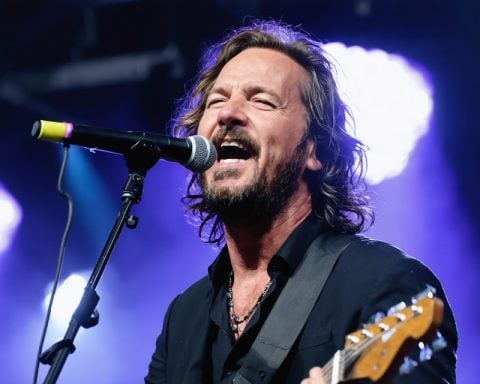- UCLA’s campus witnessed a significant protest supporting pro-Palestinian student groups facing suspension.
- The protest involved nearly a hundred people rallying from Royce Hall to Murphy Hall.
- Suspension followed an incident involving UC Regent Jay Sures and alleged harassment at his home.
- UCLA’s Office of Student Conduct is investigating the incident amidst claims of peaceful protest from students.
- The events highlight ongoing tensions at UCLA related to race, politics, and the handling of dissent.
- The protests reflect broader questions about the limits and costs of protest and representation.
- UCLA remains a focal point for larger global conversations around rights and justice.
Tumult swept through UCLA’s verdant campus as a vibrant sea of supporters gathered to rally behind pro-Palestinian student groups facing suspension. The sunny afternoon was contrasted by the charged atmosphere as nearly a hundred voices resonated from beneath the storied arches of Royce Hall. With determined strides, the protesters flooded the tree-lined avenues towards Murphy Hall, their chants echoing through academic sanctuaries and open quads.
These students stood defiant against the university’s decision to suspend Students for Justice in Palestine and Graduate Students for Justice in Palestine. The suspension followed an incident involving UC Regent Jay Sures, a noted supporter of Israel, who reportedly encountered harassment outside his home. A statement from UCLA’s Chancellor mentioned red handprints left on Sures’ residence—a stark symbol of the protest’s intensity—and how the Regent’s family vehicle was hemmed in.
Administrative proceedings loom over these student groups, with UCLA’s Office of Student Conduct diving into the complex web of campus policy and protest. Yet, the clamorous marchers insist their actions remained peaceful and dispute any portrayed violence.
The backdrop to these events is a history at UCLA punctuated by race, politics, and protest. Last year’s upheavals directed the spotlight on how the institution handles dissent, making this latest surge yet another chapter in its ongoing story.
As these demonstrations unfold, they underscore the enduring struggle for voices to be heard in the intricate dance of rights, representation, and repercussions. UCLA’s campus, with all its academic prestige, continues to be a battleground for beliefs and justice—a microcosm of larger global dialogues. Who determines the bounds of protest, and at what cost, remains a persistent question drawing eyes to this historic university setting.
UCLA Protest Drama: An In-Depth Look at Campus Activism and Its Implications
Understanding the UCLA Protests: A Comprehensive Analysis
The protests at UCLA involving pro-Palestinian student groups have captured widespread attention, highlighting the complex dynamics of campus activism. The controversy surrounding the suspension of the groups “Students for Justice in Palestine” and “Graduate Students for Justice in Palestine” has raised numerous questions about freedom of speech, campus policies, and the limits of protest. Below, we delve into several key aspects that were not fully explored in the initial report, offering a more nuanced view of the situation.
How-To Steps & Life Hacks: Organizing Peaceful Protests on Campus
1. Know Your Rights: Familiarize yourself with your university’s policies on protests and demonstrations. Most institutions provide guidelines on how to conduct protests legally on campus grounds.
2. Plan Thoroughly: Develop a clear message and objective for your protest. Ensure that the logistics, such as obtaining necessary permits and notifying campus security, are in place.
3. Promote Non-Violence: Clearly communicate the importance of peaceful protest to all participants, emphasizing respect for property and individuals.
4. Document Everything: Record the protest with photos and videos to protect against potential misrepresentations and provide evidence if needed.
Real-World Use Cases: Impact of Campus Protests
Campus protests can lead to significant real-world changes. Historical examples include the Free Speech Movement at UC Berkeley in the 1960s, which was pivotal in reforming university policies nationwide. Protests can also influence public policy or corporate practices when they attract media attention and public support.
Market Forecasts & Industry Trends: The Future of Campus Activism
Trends: Campus activism is expected to continue evolving with the integration of digital tools. Social media platforms enhance the reach and impact of student protests, making it easier for movements to gain momentum quickly.
Forecasts: Experts suggest that as universities strive to balance free speech with safety and inclusivity, policy reforms are likely to be seen across campuses, setting new precedents for handling activism.
Reviews & Comparisons: Campus Policies Across Universities
Comparing UCLA’s approach to protest management with institutions like UC Berkeley or Stanford reveals varied interpretations of free speech. While UCLA has recently faced criticism, UC Berkeley is often lauded for its progressive stance. However, both universities are constantly evaluating how best to protect student rights while maintaining order.
Controversies & Limitations: Free Speech vs. Safety
The core controversy revolves around whether UCLA’s actions against the student groups infringe on free speech or are a justified response to safety concerns. The fine line between these considerations often leads to debates on campuses nationwide.
Features, Specs & Pricing: Cost of Campus Protests
While there is no direct monetary “pricing” for protests, they often require budgeting for permits, security, materials, and promotional efforts. These logistics can become costly, especially for student-led initiatives.
Security & Sustainability: Ensuring Safe Demonstrations
Universities generally have protocols in place for ensuring the safety of both protestors and other campus members. Sustainable protests consider the environmental impact, using digital flyers instead of paper and encouraging participants to carpool or use public transport.
Insights & Predictions: What’s Next for UCLA?
The ongoing administrative proceedings may set important precedents for how future protests are handled at UCLA and beyond. If the suspension of the groups is upheld, it may discourage protests; conversely, if reversed, it might embolden student activism.
Tutorials & Compatibility: Utilizing Technology in Activism
Utilizing social media platforms like Twitter and Instagram can amplify your message to a broader audience. Creating live streams of protests can also engage supporters who cannot physically attend.
Pros & Cons Overview: Engaging in Campus Protests
Pros:
– Amplifies important issues and can lead to institutional change.
– Empowers students to exercise their democratic rights.
– Raises awareness and educates others about specific causes.
Cons:
– Can lead to disciplinary action if not compliant with campus policies.
– Potential for misinterpretation or misrepresentation in media.
– Risk of escalation if not carefully managed.
Actionable Recommendations
– Stay Informed: Continuously educate yourself on campus policies and current events to effectively advocate for your cause.
– Engage Diplomatically: Whenever possible, engage in dialogue with university administration to seek collaborative solutions.
– Network Widely: Build alliances with other student groups to broaden support and resources.
For more insights on managing campus protests and understanding free speech rights, explore platforms like the American Civil Liberties Union at ACLU.
By understanding both the broader context and the tactical aspects of campus activism, students can better navigate the challenges and opportunities of advocating for their beliefs within university settings.



















